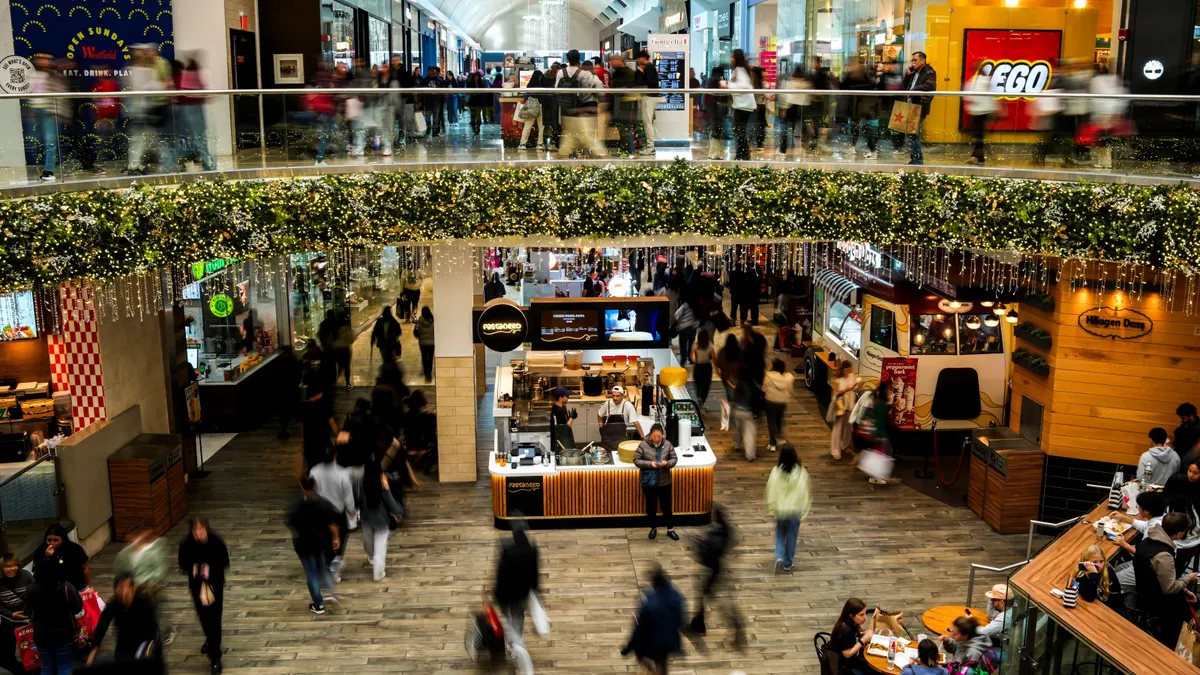Upon entering the Whole Foods store on Third Avenue in Manhattan’s Upper East Side yesterday evening, shoppers passed by a sign showing a pair of dirt-coated hands holding a stack of tomatoes. "We’re Growing Something Good," the sign read, with the phrase, "This is just the beginning," appearing in smaller font just below. At the bottom of the sign were the two logos, together at last: Whole Foods + Amazon.
Yesterday marked Amazon’s first day as the owner of the iconic — and troubled — specialty retailer. Following an acquisition that went from announcement to done deal in less than three months, the online giant took the reins of its first retail chain, in what many see as the beginning of its quest for grocery industry dominance.
'Affordable for all'
Amazon certainly didn’t temper these expectations last week, when it announced it wanted to make organic foods "affordable for all." The company unveiled numerous price cuts as well as plans to use Amazon Prime for Whole Foods’ loyalty program and offer the grocers’ private label products through its various online shopping channels.
At the Manhattan location, as in locations across the country, deep discounts appeared in categories throughout the store. This included $9.99 per pound farmed salmon that regularly sells for $14.99; organic Fuji apples for $1.99 per pound, down from $3.49; organic Whole Trade bananas for $0.69 per pound, down from $0.99 per pound; and organic avocados, which sold for $1.99 each, a dollar less than their usual $2.99 price.
Barclays Research found Whole Foods lowered prices on these "best-selling staples," touted in its announcement last week, by 25.4% in New York. However, the firm also "spot checked prices on a number of high-frequency items," such as Organic Valley milk, Newman’s Own salad dressing and Ben & Jerry’s ice cream, finding their prices remained unchanged. "[This] suggests that the current round of price investments is potentially not as broad as feared," Barclays wrote in a note emailed to Food Dive.
Deep price cuts are a common tactic for Amazon, which is all too happy to sacrifice profit for increased market share. It’s the same strategy the company has deployed in books, electronics, apparel and other categories on its way to disrupting and ultimately dominating those segments. For grocers and mass merchants like Walmart and Target (very few of whom have the same ability to absorb losses), Amazon's aggressive strategy is unsettling to say the least.
Mass merchants like Target and Walmart stand to lose the most from Amazon’s push into physical grocery with Whole Foods. Target, in particular, which has struggled over the years to sprout a successful grocery strategy, has considerable overlap with Amazon’s more affluent Prime customers, according to data from Prosper Insights & Analytics' monthly consumer survey.
As the nation’s largest seller of groceries with category sales of $170 billion last year, Walmart is not likely to let Amazon’s Whole Foods deal spoil its dominance in the sector. Grocery is key to driving foot traffic in stores and increasing customer loyalty. Over the last year, the big-box retailer has made investments in several click-and-collect programs, stand-alone grocery pickup sites, Uber delivery services and even automated 24-hour pickup towers. Meanwhile, Walmart seems to have a clear understanding that it won’t succeed in the new era of retailing with store improvements alone.
The retailer has been making strides to better compete (with Amazon and others) online with notable acquisitions such as Jet, Bonobos, Modcloth and Moosejaw.
"The question for many as they try to figure out a counter-strategy will be how much they are able to match Amazon’s prices and manage the delicate balance between retaining customers and maintaining margins and profitability," Charlie O’Shea, Moody’s Investors Service lead retail analyst, wrote in a note emailed to Retail Dive. "As we have seen multiple times, and in multiple product segments, Amazon has the advantage of not facing the same scrutiny surrounding its profitability from its shareholders as other competitors, and we believe the company will continue to exploit this in the grocery segment. That said, we continue to believe that larger players like Walmart are well-equipped via their scale to manage through this promotional period with minimal upset."
"We continue to believe that larger players like Walmart are well-equipped via their scale to manage through this promotional period with minimal upset"

Charlie O’Shea
Moody’s Investors Service lead retail analyst
Amazon is cutting prices strategically, in a way that grabs consumers’ attention and reinforces the Whole Foods brand and standards. Shoppers are used to specials — but they’re not used to getting $5 off sustainably farmed salmon filets or 43% off organic apples.
Megan Levinson, a publicist perusing the baby aisle, said she shops regularly at Whole Foods and welcomes the discounts and the new ownership. As a new mom, she likes the grocer’s wide selection of organic produce, which she’ll use to make baby food, but said the prices are often too high.
"If [Amazon] could offer more discounts on organic produce, that would be a definite plus," she told Food Dive.
Levinson was one of several customers who said they were pleased to see Whole Foods’ lower prices. Angelo Diaz, who stopped by the Upper East Side store on his way home from work at an accounting firm, said he noticed more price specials than he usually sees in the store. He said he’d like to see Amazon integrate more technology into the store, such as a cashier-free checkout system similar to Amazon Go.
"If it’s cheaper and it makes my life easier, I’m all for it," he told Food Dive.
It’s difficult to tell if Amazon’s initial price cuts are a headline-grabbing gimmick — or if the company plans to offer deep discounts regularly. Barclays Research called the price cuts "PR at its best," adding that while they "believe Amazon will undoubtedly make Whole Foods a more competitive format over time — the price cuts account for less than 1% of total SKUs in Whole Foods stores. In other words, significant price reductions on a small number of items do not meaningfully change Whole Foods’ competitive positioning or industry profitability."
Amazon is typically a fast-follower on price, often swooping in with the lowest offer after gathering data from its competitors. But with Whole Foods, the online retailer has positioned itself early on as a low price leader. Analysts have pegged Whole Foods’ prices at 15% above most supermarkets, meaning Amazon needs to make significant cuts regularly in order to shift the grocers’ image from "whole paycheck" to low-price.
Over time, of course, Amazon will adjust to the pricing nuances of owning a physical chain. Given that Whole Foods shoppers tend to be more affluent, the e-commerce giant may not need to cut so deeply. Doing so, in fact, could damage its premium image.
"While consumers often bemoan the prices at Whole Foods, higher prices come with higher perceptions of quality."

Beth Vallen
Professor, Villanova School of Business
"While consumers often bemoan the prices at Whole Foods, higher prices come with higher perceptions of quality," Beth Vallen, associate professor of marketing and business law at Villanova School of Business, wrote in a note emailed to Food Dive. "It is interesting to consider what cutting prices will mean for consumer inferences related to the quality of items in their basket and, in turn, the Whole Foods brand."
'Fresh groceries, to your home'
Low prices weren’t the only changes on display at the new Amazon-run Whole Foods location in the Upper East Side of Manhattan. Interestingly, there was new signage throughout the store promoting the grocer’s online shopping platform. A placard hung above the organic apples, promising shoppers "fresh groceries, to your home." The same slogan appeared on shelf talkers, banners and signs posted on freezer doors. The store’s front end, meanwhile, was plastered with Whole Foods' online ordering URL.
It seems a bit odd that Amazon would so heavily promote the service, which is run by Instacart and many experts believe is on the chopping block for Whole Foods. However, Amazon is making clear on day one that it’s focused on online shopping as well as in-store shopping, and wants to promote the habit with customers ahead of its own expected platform, whatever that might be. There’s lots of speculation that Amazon will eventually use its AmazonFresh service for Whole Foods' store delivery program, and that Amazon will make progress towards unlocking the puzzle of last-mile delivery. The company will also likely want to offer some form of click-and-collect, given how many of its competitors are providing the service and how popular it is, especially in suburban markets.
In the produce department, Amazon offered a display of "Farm Fresh" Amazon Echo Dots for half off. This was as sure a sign as any that the online company has a lot to learn about brick-and-mortar merchandising. Still, the gimmick caught a lot of peoples’ attention, and may signal Amazon’s willingness to sell devices and other nonfood items in stores. It could also hint at Amazon’s intention to make voice ordering a key part of its online grocery ecosystem.
As numerous signs throughout the store note, this is all just the beginning. But will it be the beginning of successful venture for a company that has zero experience operating a grocery chain and must compete against a crowded industry filled with top performers? Only time will tell.
In the meantime, industry observers anxiously await Amazon’s next moves in private label, e-commerce, store merchandising and more, expecting remarkable things from a company that has redefined retail over the past two decades.
"You have this competitor who can reimagine the store in ways the old physical-first stores cannot," Michelle Grant, head of retailing at Euromonitor International, recently told Food Dive.
Corinne Ruff contributed to this story.























